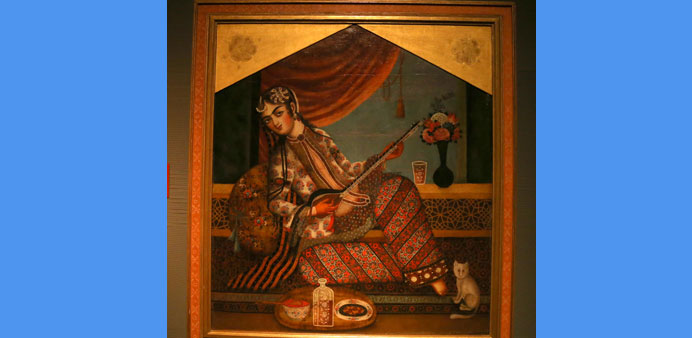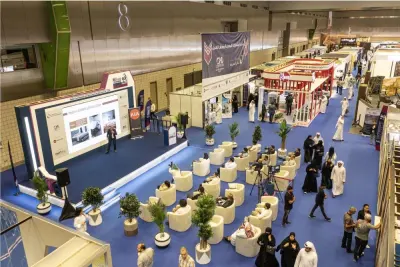The exhibition features many paintings, such as the ‘Portrait of a Lady Playing
a Mandolin’. PICTURE: JAYAN ORMA
By Joey Aguilar/Staff Reporter
The Museum of Islamic Art (MIA) yesterday opened the “Qajar Women: Images of Women in 19th-Century Iran” exhibition, which features a variety of artworks from the Qajar period.
“The temporary exhibition showcases 40 pieces of artworks, depicting the life of Persian women, and 16 photographs from the Harvard University library,” said Dr Nur Sobers-Khan, curator for Turkey at MIA.
Under the patronage of Qatar Museums chairperson HE Sheikha Al Mayassa bint Hamad bin Khalifa al-Thani, the exhibition includes artworks that reflect various interpretations of female musicians, aristocratic women, women at the court and in private quarters, all exploring the rarely-told narratives of the Qajar artistic tradition.
“These historical objects date from that period and all of the objects are from our collection and we supplemented these objects with photographs from the period and from the 19th century contemporary artworks,” she explained.
The Qajar period has inspired many contemporary artists from Iran, including Hojat Amani, Shadi Ghadirian and Mahmood Sabzi, who adopt the iconic Qajar aesthetic to comment on modernity and femininity, as well as the role of the past in shaping the present.
Set up at MIA’s Temporary Exhibition Galleries on the fourth floor, the exhibition is divided into four themes: Notions of Beauty: Images of Women in Qajar Art; Daily Life; Women, Power,and Refinement; and Women as Symbols in Art.
A wide variety of objects such as lacquers, watercolours, manuscripts, jewellery, ceramics and metalwork were included in the displays.
Artist Emile Duhousset’s “Portrait of a Woman (Iran and France, circa 1860-70)” demonstrates how the depiction of female beauty differs according to the cultural context of the artist, who is a French traveller.
The “Mirror Case (Qajar Iran, circa 1820)” artwork features a portrait of a Qajar prince on the outer cover and an intimate image of a coquettish lady on the inside of the case.
The exhibition also features the “Case containing jeweller’s tools (Qajar Iran, 19th century)”, which shows the Christian image of the Virgin Mary and Child. It is abstracted from its original context and has come to represent feminine beauty.
Dr Mounia Chekhab-Abudaya, curator for North Africa and Iberia at MIA, told reporters that the three contemporary artists contributed with reproductions of their artworks.
“They got inspired by the Qajar period and Qajar women, especially for the artworks that we have chosen for this exhibition,” she noted. “We have photographs from the Harvard University library that we reproduced as well just to give a historical context for the exhibition.”
A number of artworks by contemporary artists who were inspired by Qajar iconography are also displayed at the exhibition, demonstrating how the imagery of Qajar women continues to inspire artists today.
“This innovative exhibition is designed to completely change the perception of Qajar art as a male-dominated medium,” MIA director Aisha al-Khater said in a statement.
Until now, the most popular representations of the Qajar era (1779 to 1925) have been of male sovereigns whose life-size portraits exaggerate masculinity to depict power.
“The wide variety of objects and artworks on display illustrate the ways in which images of women can be used to understand the history of their daily lives, their roles in aristocratic pursuits, how notions of feminine beauty change over time and how women were used as symbols in Qajar art.”
MIA offers special programmes for the public, especially women, academics and families. These include daytime tours with curators, family activities on weekends and a learning beyond the classroom event scheduled for teachers, among others.
Dr Abudaya and Dr Khan will also deliver a special talk titled “Beauty and Moustaches in Qajar Art” next month.
The curators urge visitors to share their photographs of the exhibition on social media using #QajarWomen



